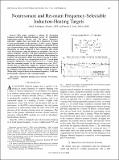| dc.contributor.author | Rodriguez, John I. | |
| dc.contributor.author | Leeb, Steven B. | |
| dc.date.accessioned | 2012-03-30T20:51:05Z | |
| dc.date.available | 2012-03-30T20:51:05Z | |
| dc.date.issued | 2010-08 | |
| dc.date.submitted | 2009-09 | |
| dc.identifier.issn | 0278-0046 | |
| dc.identifier.issn | 1557-9948 | |
| dc.identifier.other | INSPEC Accession Number: 11464241 | |
| dc.identifier.uri | http://hdl.handle.net/1721.1/69907 | |
| dc.description.abstract | This paper examines a scheme for developing frequency-selectable induction-heating targets for stimulating temperature-sensitive polymer gels. The phrase “frequency selectable” implies that each target has a frequency at which it heats preferentially in the presence of other targets. Targets using both nonresonant and resonant designs are discussed. In the case of nonresonant targets, single-turn conductors whose critical dimensions are small compared to their associated skin depth (over the frequency range of interest) are examined. One way to achieve frequency selectivity with these nonresonant targets is by designing each to have the same self-inductance while forcing the resistance of each target to differ from the previous one by a specified factor (α). In this way, a target driven at its R/L break-point frequency will heat by at least a factor of (α² + 1)/(2 α) more than the remaining targets. In the resonant-target case, RLC circuits that are inductively coupled to a primary induction coil are examined. Frequency selectivity in resonant targets is achieved by designing each target to have a different resonant frequency. When such a target is driven at its resonant frequency, it will heat preferentially compared to the remaining targets. | en_US |
| dc.description.sponsorship | National Science Foundation (U.S.). Materials Research Science and Engineering Centers (Program) | en_US |
| dc.description.sponsorship | Grainger Foundation | en_US |
| dc.description.sponsorship | Ford Motor Company | en_US |
| dc.language.iso | en_US | |
| dc.publisher | Institute of Electrical and Electronics Engineers (IEEE) | en_US |
| dc.relation.isversionof | http://dx.doi.org/10.1109/tie.2009.2037676 | en_US |
| dc.rights | Article is made available in accordance with the publisher's policy and may be subject to US copyright law. Please refer to the publisher's site for terms of use. | en_US |
| dc.source | IEEE | en_US |
| dc.title | Nonresonant and Resonant Frequency-Selectable Induction-Heating Targets | en_US |
| dc.type | Article | en_US |
| dc.identifier.citation | Rodriguez, John I, and Steven B Leeb. “Nonresonant and Resonant Frequency-Selectable Induction-Heating Targets.” IEEE Transactions on Industrial Electronics 57.9 (2010): 3095–3108. Web. 30 Mar. 2012. © 2010 Institute of Electrical and Electronics Engineers | en_US |
| dc.contributor.department | Massachusetts Institute of Technology. Department of Electrical Engineering and Computer Science | en_US |
| dc.contributor.approver | Leeb, Steven B. | |
| dc.contributor.mitauthor | Leeb, Steven B. | |
| dc.relation.journal | IEEE Transactions on Industrial Electronics | en_US |
| dc.eprint.version | Final published version | en_US |
| dc.type.uri | http://purl.org/eprint/type/JournalArticle | en_US |
| eprint.status | http://purl.org/eprint/status/PeerReviewed | en_US |
| dspace.orderedauthors | Rodriguez, John I; Leeb, Steven B | en |
| dc.identifier.orcid | https://orcid.org/0000-0002-3856-6005 | |
| mit.license | PUBLISHER_POLICY | en_US |
| mit.metadata.status | Complete | |
